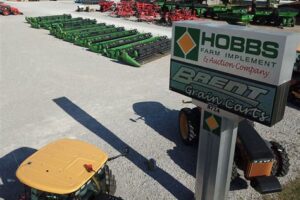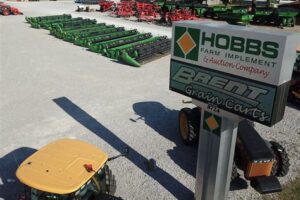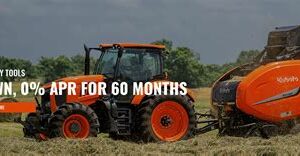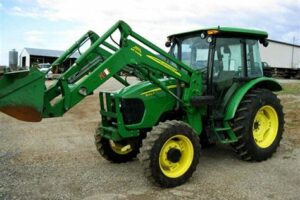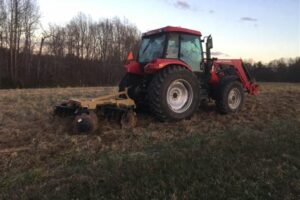Table of Contents
The depreciation life of farm equipment refers to the estimated period over which the value of agricultural machinery and tools is expected to decline. It plays a crucial role in determining the financial expenses and profits associated with farming operations. Understanding the depreciation life helps farmers make informed decisions regarding equipment purchases, replacement, and maintenance, ultimately impacting the overall efficiency and profitability of their farming business.
When it comes to running a successful farm, having reliable and efficient equipment is key. However, as any farmer knows, the lifespan of farm equipment can be quite limited. This is where understanding the concept of depreciation life becomes crucial. By comprehending how long you can expect your equipment to last, you can make informed decisions about when to repair or replace your machinery. So, let’s delve into the world of depreciation life and explore its significance in the agricultural industry.
The Importance of Understanding Depreciation Life of Farm Equipment
As a farmer, it is crucial to have a clear understanding of the depreciation life of your farm equipment. Knowing how long you can expect your machinery to last and when it will need to be replaced or repaired is essential for effective financial planning and budgeting. This article will discuss the concept of depreciation life, factors that affect it, and the importance of accurately estimating the lifespan of your farm equipment.
What is Depreciation Life?
Depreciation life refers to the period over which an asset, in this case, farm equipment, is expected to provide value and generate income. It represents the estimated useful life of the machinery before it becomes obsolete or no longer economically viable to operate. Understanding the depreciation life of your farm equipment allows you to make informed decisions about when to replace or upgrade your machinery.
Factors Affecting Depreciation Life
Several factors influence the depreciation life of farm equipment:
Maintenance and Care
Proper maintenance and care play a significant role in extending the depreciation life of farm equipment. Regular servicing, cleaning, and addressing any issues promptly can help prevent unnecessary wear and tear, ensuring that your machinery lasts longer and performs optimally.
Equipment Quality
The quality of the equipment you purchase also affects its depreciation life. Investing in high-quality machinery from reputable manufacturers can result in a longer lifespan, as these machines are often built to withstand the rigors of farm work and are less prone to breakdowns or failures.
Frequency of Use
The frequency at which you use your farm equipment impacts its depreciation life. Equipment that is consistently used for long hours and under demanding conditions will likely experience more wear and tear, shortening its useful life compared to machinery that is used less frequently or in less strenuous operations.
Nature of Work
The nature of the work performed by the equipment can also affect its depreciation life. Heavy-duty tasks that require maximum power and exertion may lead to faster deterioration of the machinery compared to lighter or less challenging jobs.
Why Accurate Estimation Matters
Accurately estimating the depreciation life of your farm equipment is vital for effective financial planning. It allows you to anticipate future expenses related to repairs, maintenance, and replacement. By understanding when your machinery is likely to reach the end of its useful life, you can budget accordingly and avoid unexpected financial burdens.
Financial Implications
Understanding the depreciation life of your equipment can help you determine the optimal time for equipment replacement. By replacing machinery at the right time, you can avoid costly repairs and potential downtime that could impact your productivity and profitability. Additionally, it enables you to calculate depreciation expenses accurately for tax purposes, potentially reducing your overall tax liability.
Monitoring and Assessing Equipment Life
To effectively manage the depreciation life of your farm equipment, it is essential to implement a system for monitoring and assessing the condition of your machinery regularly. Keep detailed records of maintenance and repairs, track usage patterns, and conduct periodic inspections to identify signs of wear or aging. By doing so, you can make informed decisions about when to repair, replace, or upgrade your equipment.
Conclusion
Understanding the depreciation life of your farm equipment is crucial for effective financial planning and decision-making. By considering factors such as maintenance, equipment quality, frequency of use, and nature of work, you can estimate the lifespan of your machinery more accurately. This knowledge allows you to budget for future expenses, optimize equipment replacement, and ensure the smooth operation of your farm.
Definition and Importance of Depreciation Life
Depreciation life refers to the expected period over which a farm equipment’s value is written off. It is crucial to determine the depreciation life of farm equipment as it allows for accurate financial reporting, taxation, and decision-making. Proper evaluation of depreciation life helps farmers understand the lifespan of their assets and plan for replacements or upgrades accordingly.
Factors Influencing Depreciation Life
Several factors influence the depreciation life of farm equipment. The primary factor is the type and quality of machinery, as well as its usage and maintenance practices. Additionally, external factors such as technological advancements, changes in industry standards, and fluctuations in market demand for certain types of equipment also play a role in determining the depreciation life of farm equipment.
Evaluation Methods
Farmers have various methods to evaluate the depreciation life of their equipment. The most common methods include the straight-line method, which evenly distributes the depreciation expense over the useful life of the asset, and the declining balance method, which allows for higher depreciation expenses during the early years of the asset’s life. Farmers can select the evaluation method that best aligns with their financial goals and the expected usage of their equipment.
Depreciation Life for Different Types of Farm Equipment
The depreciation life varies among different types of farm equipment. For instance, tractors and combines generally have a depreciation life of around 10 to 15 years due to their heavy usage and exposure to tough working conditions. On the other hand, less frequently used equipment, like irrigation systems or farm scales, may have a longer depreciation life of 20 to 30 years.
Tax Implications
Recognizing the correct depreciation life is essential for tax purposes. The tax authorities often provide guidelines or tables specifying the depreciation rates for different types of farm equipment based on their typical useful lives. Farmers should ensure they are compliant with these regulations to accurately calculate their tax liabilities and benefits associated with depreciation.
Impact of Additional Features and Modifications
The depreciation life of farm equipment can vary if additional features or modifications are made to the original equipment. Adding upgrades or making modifications can extend the equipment’s useful life, allowing for a longer depreciation period. Conversely, removing or altering certain features may shorten the equipment’s depreciation life due to decreased functionality or value.
Residual Value Considerations
Farmers should also consider the residual value of their equipment while determining the depreciation life. The residual value represents the estimated amount the equipment can be sold for at the end of its useful life. A higher residual value can lead to a shorter depreciation life, while a lower residual value may result in a longer depreciation period.
Monitoring and Adjusting Depreciation Life
Farmers should regularly assess their equipment’s productivity, maintenance costs, and technological advancements to ensure the depreciation life is accurately estimated. If unexpected changes or improvements occur, it may be necessary to adjust the depreciation life of farm equipment to align with the asset’s actual usage and economic value.
As a professional in the field of agriculture, I understand the importance of utilizing farm equipment efficiently and effectively in order to maximize productivity and profitability. One key aspect that needs to be considered when assessing the performance of farm equipment is its depreciation life.
1. Depreciation life refers to the period over which the value of an asset is expected to decline. In the case of farm equipment, it represents the number of years that the equipment is estimated to be useful in generating income for the farm operation. This estimation is based on various factors such as the type of equipment, its condition, and the rate of technological advancements in the industry.
2. Understanding the depreciation life of farm equipment is crucial for several reasons. Firstly, it helps in determining the optimal time for replacement or upgrading of equipment. By considering the remaining useful life of an asset, farmers can make informed decisions about when to sell or trade in their existing equipment to minimize losses and take advantage of technological advancements that enhance efficiency.
3. Additionally, knowledge of depreciation life aids in accurate financial planning and budgeting. It allows farmers to estimate the future costs associated with equipment maintenance, repairs, and eventual replacement. By incorporating these projected expenses into their financial plans, farmers can allocate resources effectively and ensure the long-term sustainability of their operations.
4. Furthermore, understanding the depreciation life of farm equipment is essential for tax purposes. Depreciation is a deductible expense that reduces taxable income, thereby lowering the overall tax liability for farmers. By accurately estimating the depreciation life of their equipment, farmers can claim appropriate deductions and optimize their tax benefits.
5. It is worth noting that the depreciation life of farm equipment can vary significantly depending on several factors. Factors such as the intensity of use, maintenance practices, and environmental conditions can influence the actual useful life of equipment. Therefore, it is crucial for farmers to regularly assess the condition of their equipment and adjust their depreciation estimates accordingly.
In conclusion, the depreciation life of farm equipment plays a vital role in the decision-making process of farmers. It helps determine the optimal time for replacement or upgrading, aids in financial planning and budgeting, and provides tax benefits. By understanding and carefully managing the depreciation life of their equipment, farmers can enhance the efficiency and profitability of their operations.
Thank you for taking the time to visit our blog and learn more about the depreciation life of farm equipment. As professionals in the agricultural industry, we understand the importance of making informed decisions when it comes to managing your assets and maximizing their value. Depreciation is a critical factor to consider when evaluating the financial impact of your equipment, and we hope this article has provided you with valuable insights.
One key aspect to keep in mind is that the depreciation life of farm equipment can vary greatly depending on several factors. The type of machinery, its usage patterns, maintenance practices, and market conditions all play a role in determining how quickly an asset depreciates. It is essential to conduct thorough research and consult with experts to accurately estimate the depreciation life of your specific equipment.
Understanding the depreciation life of farm equipment allows farmers and agricultural businesses to make better financial decisions. By knowing how long an asset is expected to last before losing substantial value, you can plan for replacement or upgrade costs more effectively. Additionally, understanding depreciation helps in budgeting for repairs and maintenance, as older equipment tends to require more frequent and costly repairs.
In conclusion, we hope this article has shed light on the importance of considering the depreciation life of farm equipment. By being aware of this crucial aspect, you can make more informed decisions regarding your machinery, ensuring optimal financial management. Remember to conduct thorough research, consult with experts, and regularly assess the condition of your equipment to stay ahead in the ever-evolving agricultural industry.
Thank you once again for visiting our blog, and we encourage you to explore other articles that delve into various topics related to the agricultural sector. If you have any questions or would like further information, please do not hesitate to reach out to us. We are here to assist you and provide you with the knowledge and resources necessary for success in farming.
Video Depreciation Life Of Farm Equipment
Here are some common questions that people also ask about the depreciation life of farm equipment:
-
What is the depreciation life of farm equipment?
The depreciation life of farm equipment refers to the period over which the equipment’s value is expected to decline. It is an estimate of the equipment’s useful life before it becomes obsolete or no longer economically viable.
-
How is the depreciation life of farm equipment determined?
The depreciation life of farm equipment is typically determined by considering factors such as the type of equipment, its expected usage, technological advancements, maintenance requirements, and the industry’s standards. Different types of farm equipment may have varying depreciation lives.
-
Why is knowing the depreciation life of farm equipment important?
Knowing the depreciation life of farm equipment is crucial for farmers and agricultural businesses as it helps them plan their equipment purchases, budget for replacements, and calculate the actual cost of using the equipment over its lifespan. It also assists in determining the equipment’s resale value.
-
Does the depreciation life of farm equipment affect taxes?
Yes, the depreciation life of farm equipment can impact taxes. It is considered when calculating depreciation expenses for tax purposes. The Internal Revenue Service (IRS) provides guidelines and rules regarding the depreciation of farm equipment for tax reporting.
-
Can the depreciation life of farm equipment be extended?
In some cases, the depreciation life of farm equipment can be extended through proper maintenance, repairs, and upgrades. However, technological advancements and changes in industry practices may render certain equipment obsolete before its anticipated depreciation life is over.
Remember, the depreciation life of farm equipment may vary depending on various factors, so it is advisable to consult with financial professionals or tax experts for accurate and up-to-date information relevant to your specific situation.

